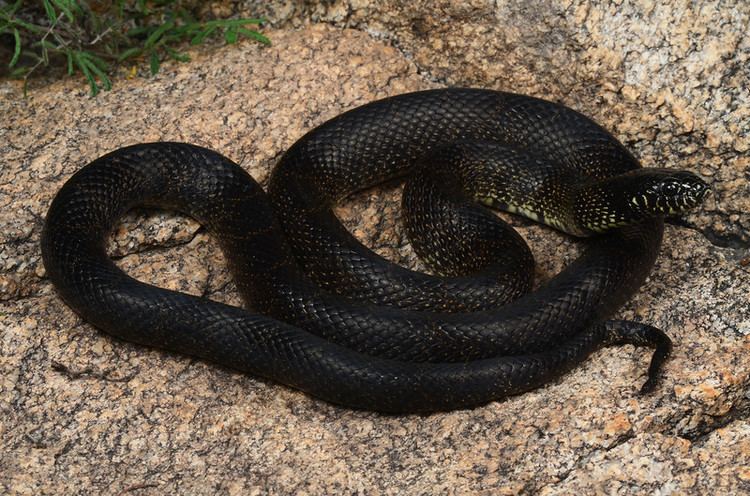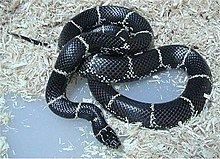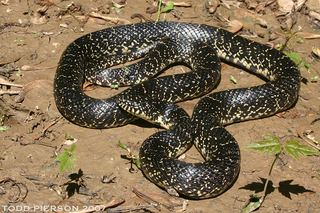Subphylum Vertebrata Suborder Serpentes Scientific name Lampropeltis getula Rank Species | Phylum Chordata Higher classification Kingsnakes | |
 | ||
Lower classifications California kingsnake, Mexican black kingsnake, Lampropeltis getula holbrooki, Desert kingsnake | ||
Lampropeltis getula, commonly known as the eastern kingsnake, common kingsnake, or chain kingsnake (more), is a harmless colubrid species endemic to the United States and Mexico. It has long been a favorite among collectors. Eight subspecies are currently recognized, including the nominate subspecies described here.
Contents
- California kingsnake lampropeltis getula californiae
- Description
- Common names
- Geographic range
- Habitat
- Diet
- Reproduction
- Captivity
- References

California kingsnake lampropeltis getula californiae
Description

Adult specimens es]] are the smallest race on average, at 91.5 cm (36.0 in) (in snout-to-vent length) on average, while the nominate is the largest, at 107 cm (42 in) on average. Specimens up to 208.2 cm (82.0 in) have been recorded. Weight can vary from 285 g (10.1 oz) in a small specimen of 87.2 cm (34.3 in) in length, to 2,268 g (80.0 oz) in large specimens, of over 153 cm (60 in) in length.

The color pattern consists of a glossy black, blue-black or dark brown ground color overlaid with a series of 23-52 white chain-like rings. King snakes from the Coastal Plain have wider bands, while those found in mountainous areas have thinner bands or may be completely black.
Common names

Eastern Kingsnake, Common Kingsnake, Chain Kingsnake, Kingsnake, Carolina Kingsnake, Chain Snake, Bastard Horn Snake, Black Kingsnake, Black Moccasin, Common Chain Snake, Cow Sucker, Eastern Kingsnake, Horse Racer, Master Snake, North American Kingsnake, Oakleaf Rattler, Pied Snake, Pine Snake, Racer, Rattlesnake Pilot, Thunder-and-Lightning Snake, Thunderbolt, Thunder Snake, Wamper, Wampum Snake. Also In North Carolina it is called the Pied Piper.
Geographic range

Found in the United States in Alabama, Arizona, Arkansas, California, portions of Colorado, Delaware, Florida, Georgia, south and southwest Illinois, southern Indiana, southern Iowa, Kansas, Kentucky, Louisiana, Maryland, Mississippi, Missouri, Nebraska, southern and western Nevada, New Jersey, New Mexico, New York, North Carolina, southern Ohio, southeastern Oklahoma, southern Oregon, South Carolina, Tennessee, Texas, southern Utah, Virginia, and West Virginia. Also found in northern Mexico, including all of Baja California.
Habitat
Open areas are preferred, particularly grassland, but also chaparral, oak woodland, abandoned farms, desert, low mountains, sand, and any type of riparian zone, including swamps, canals and streams.
Diet
They eat other snakes, including venomous snakes. They have developed a hunting technique to avoid being bitten by clamping down on the jaws of the venomous prey, but even if bitten, they are immune to the venom. They also eat amphibians, turtle eggs, lizards, and small mammals, which they kill by constriction.
Reproduction
Oviparous, females lay up to several dozen eggs that hatch after 2-2.5 months of incubation. Hatchlings are brightly colored and feed on small snakes, lizards and rodents.
Captivity
Long a favorite among collectors, they do well in captivity, living for up to 25 years or more. Some of the most popular kingsnakes kept in captivity are California, Brook's, Florida and Mexican black kingsnakes.
